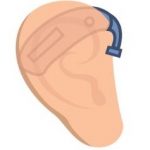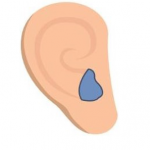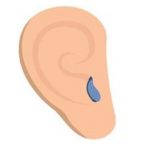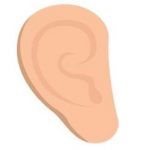Two basic hearing aid styles exist: Behind-The-Ear and In-The-Ear. There are many variations of these two styles, but they are categorized by whether the main body of the hearing aid rests on or in the ear. There are advantages and disadvantages to both. It is important to work with a specialist to determine which fit is best for you. The style of the hearing aid can affect performance, durability and cosmetics.
Behind-The-Ear Hearing Aids
 Behind-The-Ear (BTE) – Worn behind the ear with tubing connected to an earmold, BTE hearing aids work for all levels of hearing loss as well as all ages. Due to its size, more technology can be placed in BTE hearing aids such as directional microphones, Bluetooth, telecoils. Also because of their size they are the most durable hearing aid. They are easy to handle, so if you lack dexterity, these hearing aids are a nice option. They also fit a large battery that can last 2-3 weeks.
Behind-The-Ear (BTE) – Worn behind the ear with tubing connected to an earmold, BTE hearing aids work for all levels of hearing loss as well as all ages. Due to its size, more technology can be placed in BTE hearing aids such as directional microphones, Bluetooth, telecoils. Also because of their size they are the most durable hearing aid. They are easy to handle, so if you lack dexterity, these hearing aids are a nice option. They also fit a large battery that can last 2-3 weeks.
Some downsides of BTE hearing aids are that they are the most visible style of hearing aid and can be sensitive to wind interference.
 Mini Behind-The-Ear (Mini BTE) – The Mini BTE is smaller than traditional BTE hearing aids but includes many of the same features such as directional microphones, telecoils, and longer battery life than In-The-Ear hearing aid styles. When selecting a Mini BTE hearing aid, you can choose either an earmold or a receiver to sit within your ear.
Mini Behind-The-Ear (Mini BTE) – The Mini BTE is smaller than traditional BTE hearing aids but includes many of the same features such as directional microphones, telecoils, and longer battery life than In-The-Ear hearing aid styles. When selecting a Mini BTE hearing aid, you can choose either an earmold or a receiver to sit within your ear.
While this style of hearing aid is smaller than the full-size BTE, it is still a visible hearing aid.
 Receiver-In-Canal (RIC/RITE)– This is one of the most popular styles that hearing aid users choose to wear. Like BTE hearing aids, RIC hearing aids require the main body of the device to sit behind your ear. Because of it’s small size it is one of the most discreet hearing aids available. The RIC hearing aid has a thin wire extending from the body of the hearing aid to the receiver which rests in your ear canal.
Receiver-In-Canal (RIC/RITE)– This is one of the most popular styles that hearing aid users choose to wear. Like BTE hearing aids, RIC hearing aids require the main body of the device to sit behind your ear. Because of it’s small size it is one of the most discreet hearing aids available. The RIC hearing aid has a thin wire extending from the body of the hearing aid to the receiver which rests in your ear canal.
These hearing aids are easy to clean and better for those with limited dexterity. Because of their size, they also have the potential to house more tech features. They offer both an open fit as well as closed fit allowing anyone with a mild to severe hearing loss to choose the RIC as an option. Battery life is anywhere from 5-10 days with a standard battery or 10-12 months with a rechargeable battery.
In-The-Ear Hearing Aids
 In-The-Ear (ITE) – Largest of the hearing aids which rest in the ear, the ITE hearing aids are custom-made to fit in your ear. They are the only ITE type of hearing aid which works for all levels of hearing loss and are large enough to come with tech extras like directional microphones and telecoils. ITE hearing aids are also a better option for those with limited dexterity. Battery life is 12-14 days.
In-The-Ear (ITE) – Largest of the hearing aids which rest in the ear, the ITE hearing aids are custom-made to fit in your ear. They are the only ITE type of hearing aid which works for all levels of hearing loss and are large enough to come with tech extras like directional microphones and telecoils. ITE hearing aids are also a better option for those with limited dexterity. Battery life is 12-14 days.
While the ITE style hearing aid rests in your ear, there is still a highly visible portion, as they can take up a full or half-shell space in your ear. They can also cause feelings of occlusion if not vented properly.
 In-The-Canal (ITC) – The ITC hearing aid style is more discreet than the ITE style and is also custom-made to fit your ear. These hearing aids have a longer battery life (12-14 days) than the CIC or IIC hearing aid styles and can be moderately easy to handle.
In-The-Canal (ITC) – The ITC hearing aid style is more discreet than the ITE style and is also custom-made to fit your ear. These hearing aids have a longer battery life (12-14 days) than the CIC or IIC hearing aid styles and can be moderately easy to handle.
As these hearing aids rest more in your ear, they are more susceptible to moisture damage and earwax buildup. You may also feel occluded by the ITC hearing aid style and still have a visible portion.
 Completely-In-Canal (CIC) – Relatively invisible, the CIC hearing aid rests inside of your ear canal. You still have high sound fidelity even with its position in your ear, and the CIC is custom-made for a comfortable fit. Battery life ranges from 6-8 days.
Completely-In-Canal (CIC) – Relatively invisible, the CIC hearing aid rests inside of your ear canal. You still have high sound fidelity even with its position in your ear, and the CIC is custom-made for a comfortable fit. Battery life ranges from 6-8 days.
CIC style hearing aids rest almost entirely within your ear, making them more susceptible to moisture damage and earwax buildup. They also require more dexterity for handling and battery replacement.
 Invisible-In-Canal (IIC) – As the name indicates, the IIC style hearing aid sits completely within your ear canal with no visible portion, aside from the clear removal string. It is custom-made to fit comfortably in your ear.
Invisible-In-Canal (IIC) – As the name indicates, the IIC style hearing aid sits completely within your ear canal with no visible portion, aside from the clear removal string. It is custom-made to fit comfortably in your ear.
As it is very small, those with limited dexterity will struggle to handle these hearing aids. The IIC also have a shorter battery life of 4-7 days and can be very susceptible to moisture damage and earwax buildup. This is a great option if you are looking for something that is completely invisible.
 Lyric – The only 24/7 hearing aid, Lyric hearing aids sit deep inside the ear canal. It does not require batteries that you have to replace, and remains in the ear while you sleep. You can use the SoundLync tool to adjust the volume of your Lyric, remove it if needed, and adjust the power and sleep setting.
Lyric – The only 24/7 hearing aid, Lyric hearing aids sit deep inside the ear canal. It does not require batteries that you have to replace, and remains in the ear while you sleep. You can use the SoundLync tool to adjust the volume of your Lyric, remove it if needed, and adjust the power and sleep setting.
These hearing aids require a yearly subscription and must be placed by a licensed Lyric-certified hearing care provider. They are also water-resistant but should not be submerged via swimming or diving.
For a quick reference of the various available hearing aid styles, you can consult the table below.
- -Easy to clean
- -Easy to use
- -Strongest amplification
- -Can contain more tech
- -Most visible style
- -Sensitive to wind
- -Occlusion
- -Easy to clean
- -Use earmolds or receiver
- -Less wind sensitive
- -Still visible style
- -Small size difficult to handle
- -Easy to clean
- -Easy to use
- -Can contain more tech
- -Discreet
- -Can be visible on some ears.
- -Sensitive to wind
- -Custom-made
- -Low-profile
- -Easy to use
- -Visible style
- -Occlusion
- -Custom-made
- -Fairly discrete
- -Optional tech
- -Longer battery life
- -Slightly visible
- -Susceptible to earwax and moisture
- -Occlusion
- -Custom-made
- -Generally unseen
- -Minimal feedback
- -High sound clarity
- Short battery life
- -Susceptible to earwax and moisture
- -Difficult dexterity
- -Custom-made
- -Invisible in use
- -None-to-minimal feedback
- -High sound clarity
- -Short battery life
- -Susceptible to earwax and moisture
- -Difficult dexterity
- Completely invisible
- -24/7 use
- -High sound clarity
- -No battery or repairs
- -Subscription required
- -Provider help required
CROS and BiCROS Hearing Aids
If your hearing loss is due to SSD (single-sided deafness), consider using a CROS or BiCROS hearing aid. These particular hearing instruments are specifically designed to help patients with SSD to hear better. We are able to accomplish this by placing a device on the poor ear which transmits sounds to your better ear. If you have a hearing loss in your better ear, the device on that side can act as a hearing aid as well.
Other solutions involve surgical implants such as the Bone-Anchored Hearing Aid (BAHA). This is when a titanium screw is anchored in the skull bone behind the deaf ear. A vibrating sound processor is attached externally, which reads sounds and transmits them through the skull bone to the cochlea of the good ear.


